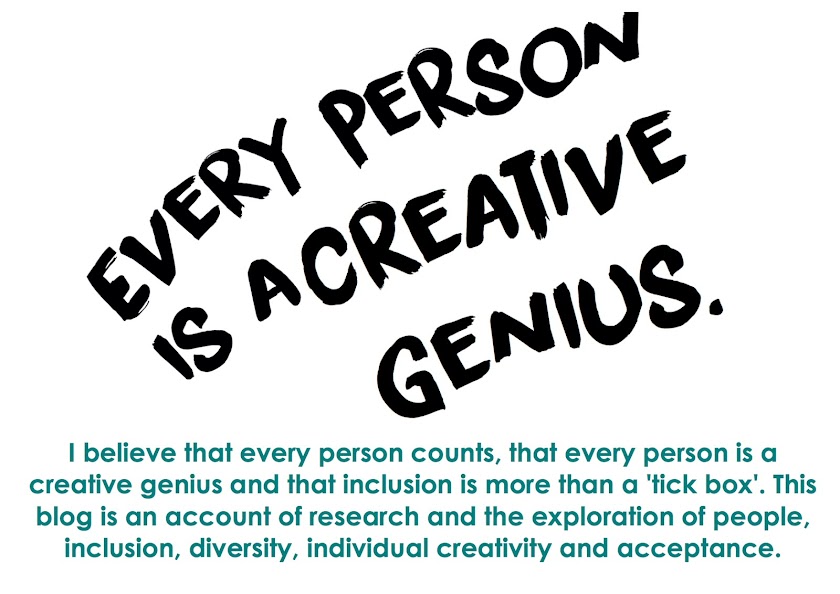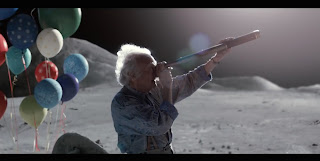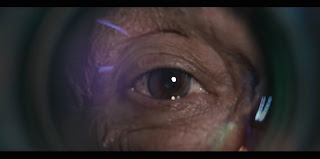After seeing #manonthemoon all over Twitter, I finally saw the John Lewis Christmas 2015 advert lat night. As I watched it, it got me thinking! It did much more than make me want to run to John Lewis to do my Christmas shopping, it inspired a ‘light-blub’ moment. As I watched, I began to see the advert as a way to explore some of the key elements that I feel are essential to making the arts more inclusive and inspiring successful inclusive arts practice.
I believe that inclusion is more than a 'tick box', that inclusion goes beyond ‘dos and don’ts’, specific ‘inclusion’ projects and ‘integration’ . Through a recent research project, I developed 12 guiding principles for inclusive arts, which you can find in previous posts. The 'light-bulb' moment made me realise that ‘The Man in the Moon’ ties-in with some of these 12 principles……….
1. We all need to be more child-like! - "Every
person should be encouraged to explore, experiment and give it a go’"
2. The Man on the Moon – "Every person deserves the best and to be the best they can be."
This
is a thought-provoking image that we can all relate to, but more than that I
think it can help us to see the very reason why arts needs to be inclusive to
all and accessible to all. No one should be the man on the moon, left out and alone; everyone should be enabled to be part of the world and its creativity, lights,
music and dancing. Everyone should be able to access this and to experience the
best that the creative world has to offer to enable them to become the best they
can be.
3. Keep trying and don't give up – “Every
person can be included with a little bit of time, some room for
expression and
a ‘listening’ ear."
The
little girl desperately wants to connect with the man in the moon and this
desire pushes her to think creativity and try many different ways to reach the
man. She waves, she writes messages and she shoots rockets in to the sky, all in
an effort to tell him she sees him and she is thinking about him. We can never
stop trying in inclusive arts practice, we need to make the time to try, to
‘listen’, to hear, to watch, to talk, and to understand. This can be frustrating
at times and it can feel like you will never connect, never breakthrough. But
by continuing to try, to experiment, to be patient, then more and more new and innovative
ways to make connections between different people with different experiences
of the world are uncovered.
4. Everyone should be invited to the party - “Every person should be treated according to the same values as anyone else
at all times and in all situations."
As the
festive season approaches, the little girl is seen celebrating with her family,
she is part of the world, part of the music and lights and dancing, but she
wants the man in the moon to be part of this too. She sees that he should be
treated the same as everyone else around her, he should be a part of the
celebrations. Obviously posting a present to the moon is tricky, but as she
proves, its not impossible. She has to think creatively and invent a whole new way
of giving a gift and this is exactly what we need to do if we are to make the
arts more inclusive – we need to think and creatively problem solve together,
we need to seek out the possibilities and investigate the ways that we can
change ‘cant do it’ to ‘can do it ’ to enable the arts to be truly inclusive.
5. The
Perfect Gift – “Every person should be
enabled to understand information and instructions
through communication in is
all its different forms.”
When the man on the moon opens the box, it's the most perfect gift for him. It is more than a kind gift and it is more than a tool, it is a key in to another world that he can now become part of. We need to be aware of what tools people need to be able to look in to the world of the arts to ensure everyone can access it, understand it and be part of if. These tools can be for the physical body, but these tools can also be emotional and these can support the mind in understanding and learning. Each person is an expert of their own reality and by talking to people we can begin to understand what tools everyone needs to become a part of the lights, music and dancing, to be able to join the party and dance. The man in the moon now has the right tools to connect, communicate and not feel alone and isolated, now he can be part of the world and can start to express himself and Lily can learn from him.
6. He looks and he sees – “Every
Person needs to adapt in someway to include others and find a middle ground to
join together on - adaptability is the key to successful inclusive arts.
For the little girl to send the man in the moon the gift he needed to join the party and be included, she had to adapt the way she sent the gift. When the man in the moon opens the box and finds the telescope, he then puts it to his eye and looks. The man in the moon does not leave it in the box and hide it; he engages with it and uses it to see into the unknown world. The little girl has been adaptable and gone 'half way' in her connection to the man by working out how to send him the gift, but he takes a step 'half way' too when he picks up the telescope and uses it. They find a middle ground on which to meet and make a connection to become explorers on a new journey together.
For the little girl to send the man in the moon the gift he needed to join the party and be included, she had to adapt the way she sent the gift. When the man in the moon opens the box and finds the telescope, he then puts it to his eye and looks. The man in the moon does not leave it in the box and hide it; he engages with it and uses it to see into the unknown world. The little girl has been adaptable and gone 'half way' in her connection to the man by working out how to send him the gift, but he takes a step 'half way' too when he picks up the telescope and uses it. They find a middle ground on which to meet and make a connection to become explorers on a new journey together.
7. What
happens next? – “Every person has a
different experience of the world and his or her
involvement in a creative
process makes the end result totally unique.”
The
advert urges to us ‘continue the story’ by linking you to the John Lewis
website where you can learn more about the man in the moon via an app and of
course where you can start your Christmas shopping and ‘Show someone they are
loved this Christmas.’ So the story doesn't end with the gift and the initial
connection with Lily and the man in the moon and it certainly wasn't the end for my
'light-bulb' moment either. It made me wonder 'What developed from their friendship and understanding?' 'What
did they go on to discover from here?' and 'What were they able to learn from each
other?'. This for me is the beginning of the story for being inclusive in the arts,
once everyone can connect with and access the arts world, the ideas are endless
as we learn from each other and begin to understand and accept each other’s
experience of the world and of being human.
8. Who is the man on the moon? – “Everyone is a creative genius”
The
man on the moon is anyone who is not or can not be a part of the arts world because
they aren’t seen, they aren’t understood, they aren’t listened to, they aren’t
invested in or believed in, they don't have the right tools or they aren’t
accepted as creative individuals. We can chose to watch as the ‘man on the
moon’ does his chores alone.
“Lily
watches as he goes about his chores, all alone up there.”-
We
can chose to leave it at that and return to our own party……..or we can be
determined to do things differently, be determined to send a message, be
determined to include everyone and be determined to see everyone as a creative
genius who should be invited to the party to enjoy the lights, the music and the
dancing with everyone else.
“She
becomes determined to get something to the moon, to send him a message and show
him that someone down here is thinking of him.”-

























































